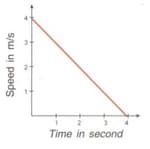A P Shreelatha and Neetu Singh Solutions for Chapter: Force and Laws of Motion, Exercise 6: EXERCISES
A P Shreelatha Physics Solutions for Exercise - A P Shreelatha and Neetu Singh Solutions for Chapter: Force and Laws of Motion, Exercise 6: EXERCISES
Attempt the practice questions on Chapter 2: Force and Laws of Motion, Exercise 6: EXERCISES with hints and solutions to strengthen your understanding. Secondary Physics solutions are prepared by Experienced Embibe Experts.
Questions from A P Shreelatha and Neetu Singh Solutions for Chapter: Force and Laws of Motion, Exercise 6: EXERCISES with Hints & Solutions
The resultant of all forces acting on a body is not zero. What is the type of force?
If the net force acting on a body is zero, will the body remain necessarily at rest?
The velocity-time graph of a body moving on a horizontal surface is shown in the adjoining figure. The mass of the body is . How much force does the surface exert on the body to bring it to rest?
A load of 100 N is applied at one end of a spring balance and an equal load is applied at the other end at the same time. What is the reading on the balance?
A wooden trolley of mass is mounted on wheels on horizontal rails. Neglecting friction and air resistance, what will be the final velocity of the trolley if a bullet of mass is fired into it with a horizontal velocity of along the direction of the rails.
A rubber ball of mass is thrown against a wall. It strikes the wall normally with a velocity of and rebounds with the same speed in the opposite direction. Calculate the impulse of the force exerted by the wall on the ball.
Two blocks of mass and are placed in contact on a frictionless horizontal surface. A force of is acting on . What is the acceleration of and . What is the value of action and reaction between the blocks?

A constant retarding force of is applied to a body of mass moving initially with a speed of . How long does the body take to come to halt?


